Regional Optimization Dynamic Algorithm for Node Placement in Wireless Sensor Networks
Abstract
1. Introduction
2. Related Work
3. Model for Regional Optimization of Node Placement
4. Regional Optimization Dynamic Algorithm for Node Placement
4.1. Re-Optimized Judgement Conditions for Node Placement
4.2. The Strategies for Optimization Region
4.2.1. Surrounding Strategy for Optimization Region
| Algorithm 1: Surrounding Strategy for Optimization Region |
 |
- (1)
- can modify the boundary of the optimization region according to the position of the dead node, so that the optimization region will not exceed the monitoring area of WSN. The distances from the position of the dead node to the boundary of the optimization region can be calculated by Equation (13).where , , and respectively represent the distances between the position of the dead node and the left boundary, right boundary, lower boundary and upper boundary of the optimization region. In the surrounding strategy for optimization region, .
- (2)
- is used to calculate the area of the optimization region and the theoretical number of nodes in this region. The equations are shown in Equations (14) and (15).where is the excepted node number of the whole monitoring area for an appropriate node density.
- (3)
- is used to collect the information of the survival nodes in the optimization region, including the number of nodes and the set of nodes .
4.2.2. Redundant Strategy for Optimization Region
| Algorithm 2: Redundant Strategy for Optimization Region |
2 ; 3 ; 4 ; 5 ; 6 ; |
- (1)
- can calculate the overlapped number for each node in WSN by Equation (16), then put the nodes with into redundant nodes set .
- (2)
- is used to calculate the distances between each node in and the dead node , then find out the closest redundant node .
- (3)
- can calculate the distances between the position of the dead node and the boundaries of the optimization region according to Equation (17).
4.2.3. Mixed Strategy for Optimization Region
4.3. Process of MRDA
5. Results and Discussion
5.1. Experimental Environment and Evaluation Indicators
5.2. Experiments on Different Random Node Death
5.3. Experiments on Different Scales of WSNs
5.4. Experiments on Different Node Densities of WSNs
6. Conclusions
Author Contributions
Funding
Conflicts of Interest
Abbreviations
| WSN | Wireless sensor network |
| LEACH | Low Energy Adaptive Clustering Hierarchy |
| NSGA2 | Fast Non-dominated Sorted Genetic Algorithm |
References
- Pottie, G.; Kaiser, W. Wireless sensor networks. Commun. ACM 2000, 43, 51–58. [Google Scholar] [CrossRef]
- Carlos, C.; Sandra, S.; Jaime, L.; Raquel, L. Smart System for Bicarbonate Control in Irrigation for Hydroponic Precision Farming. Sensors 2018, 18, 1333. [Google Scholar] [CrossRef]
- Onasanya, A.; Lakkis, S.; Elshakankiri, M. Implementing IoT/WSN based smart Saskatchewan Healthcare System. Wirel. Netw. 2019, 25, 3999–4020. [Google Scholar] [CrossRef]
- Mirza, G.F.; Ahmed, A.; Bohra, N.; Khan, S.; Memon, A.R.; Talpur, A. Performance Analysis of Location Based Smart Catastrophe Monitoring System Using WSN. Wirel. Pers. Commun. 2018, 101, 405–424. [Google Scholar] [CrossRef]
- Abdollahzadeh, S.; Navimipour, N.J. Deployment strategies in the wireless sensor network: A comprehensive review. Comput. Commun. 2016, 91–92, 1–16. [Google Scholar] [CrossRef]
- Pialy, B.; Raghavaraju, C.; Shashank, G.; Singh, R.A. Fault Detection using hybrid of KF-ELM for Wireless Sensor Networks. In Proceedings of the 2019 3rd International Conference on Trends in Electronics and Informatics, Tamil Nadu, India, 25 April 2019; pp. 746–750. [Google Scholar] [CrossRef]
- Mini, S.; Udgata, S.K.; Sabat, S.L. Sensor deployment and scheduling for target coverage problem in wireless sensor networks. IEEE Sensors J. 2014, 14, 636–644. [Google Scholar] [CrossRef]
- Gwon, Y.; Jain, R.; Kawahara, T. Robust indoor location estimation of stationary and mobile users. IEEE INFOCOM 2004, 2, 1032–1043. [Google Scholar] [CrossRef]
- Wang, G.; Yang, K. A New Approach to Sensor Node Localization Using RSS Measurements in Wireless Sensor Networks. IEEE Trans. Wirel. Commun. 2011, 10, 1389–1395. [Google Scholar] [CrossRef]
- Miguel, G.; Carlos, M.; Jesús, T.; Jaime, L. Wireless Sensors Self-Location in an Indoor WLAN Environment. Sens. Technol. Appl. 2007, 146–151. [Google Scholar] [CrossRef]
- Sandra, S.; Jaime, L.; Carlos, T.; Aguiar, J.M. IEEE 802.11a/b/g/n short-scale indoor wireless sensor placement. Int. J. Ad Hoc Ubiquitous Comput. 2014, 15, 68–82. [Google Scholar] [CrossRef]
- Xu, Y.; Zeng, Z.; Ding, O. An energy efficient hole repair node scheduling algorithm for WSN. Wirel. Netw. 2017, 12, 103–116. [Google Scholar] [CrossRef]
- Chu, H.; Wu, C.; Yu, X. The Network Holes Repair Scheme for Wireless Sensor Network. Sens. Lett. 2016, 14, 295–299. [Google Scholar] [CrossRef]
- Yaoming, Z.; Chengdong, W.; Hao, W.; Hao, C.; Yuan, G.; Li, L. The Repair Strategy for Event Coverage Holes Based on Mobile Robots in Wireless Sensor and Robot Networks. Sensors 2019, 19, 5045. [Google Scholar] [CrossRef]
- Srishti Sharma, E.; Saloni, E. Node deployment technique using hybrid DE-PSO algorithm in WSN. Int. J. Comput. Appl. 2017, 7, 7. [Google Scholar]
- Wang, Z.; Xie, H.; He, D.; Chan, S. Wireless Sensor Network Deployment Optimization Based on Two Flower Pollination Algorithms. IEEE Access 2019, 7, 180590–180608. [Google Scholar] [CrossRef]
- Hao, Z.; Xu, H.; Dang, X.; Duan, Y. A Dynamic Detection and Repair Algorithm for WSN Three-Dimensional Covering Cavity. Comput. Eng. 2019. [Google Scholar] [CrossRef]
- Khamlichi, Y.E.; Mesmoudi, Y.; Tahiri, A.; Abtoy, A. A Recovery Algorithm to Detect and Repair Coverage Holes in Wireless Sensor Network System. J. Commun. 2018, 13, 67–74. [Google Scholar] [CrossRef]
- Reda, S.M.; Abdelhamid, M.; Khalid, A. Localized Movement-Assisted Sensor Deployment Algorithm for Hole Detection and Healing. IEEE Trans. Parallel Distrib. Syst. 2014, 25, 1267–1277. [Google Scholar] [CrossRef]
- Zhang, Y.; Liu, M. Adaptive Directed Evolved NSGA2 Based Node Placement Optimization for Wireless Sensor Networks. Wirel. Networks 2020, 1–14. [Google Scholar] [CrossRef]
- Onur, E.; Ersoy, C.; Delic, H. How many sensors for an acceptable breach detection probability? Comput. Commun. 2006, 29, 173–182. [Google Scholar] [CrossRef]
- Deb, K.; Pratap, A.; Agarwal, S.; Meyarivan, T. A fast and elitist multiobjective genetic algorithm: NSGA-II. IEEE Trans. Evol. Comput. 2002, 6, 182–197. [Google Scholar] [CrossRef]
- Heinzelman, W.; Chandrakasan, A.; Balakrishnan, H. Energy-Efficient Protocol for Wireless Microsensor Networks. In Proceedings of the Hawaii International Conference on System Sciences, Maui, HI, USA, 22 September 2000; pp. 3005–3014. [Google Scholar] [CrossRef]
- Qingguo, Z.; Fok, M.P. A Two-Phase Coverage-Enhancing Algorithm for Hybrid Wireless Sensor Networks. Sensors 2017, 17, 117. [Google Scholar] [CrossRef]
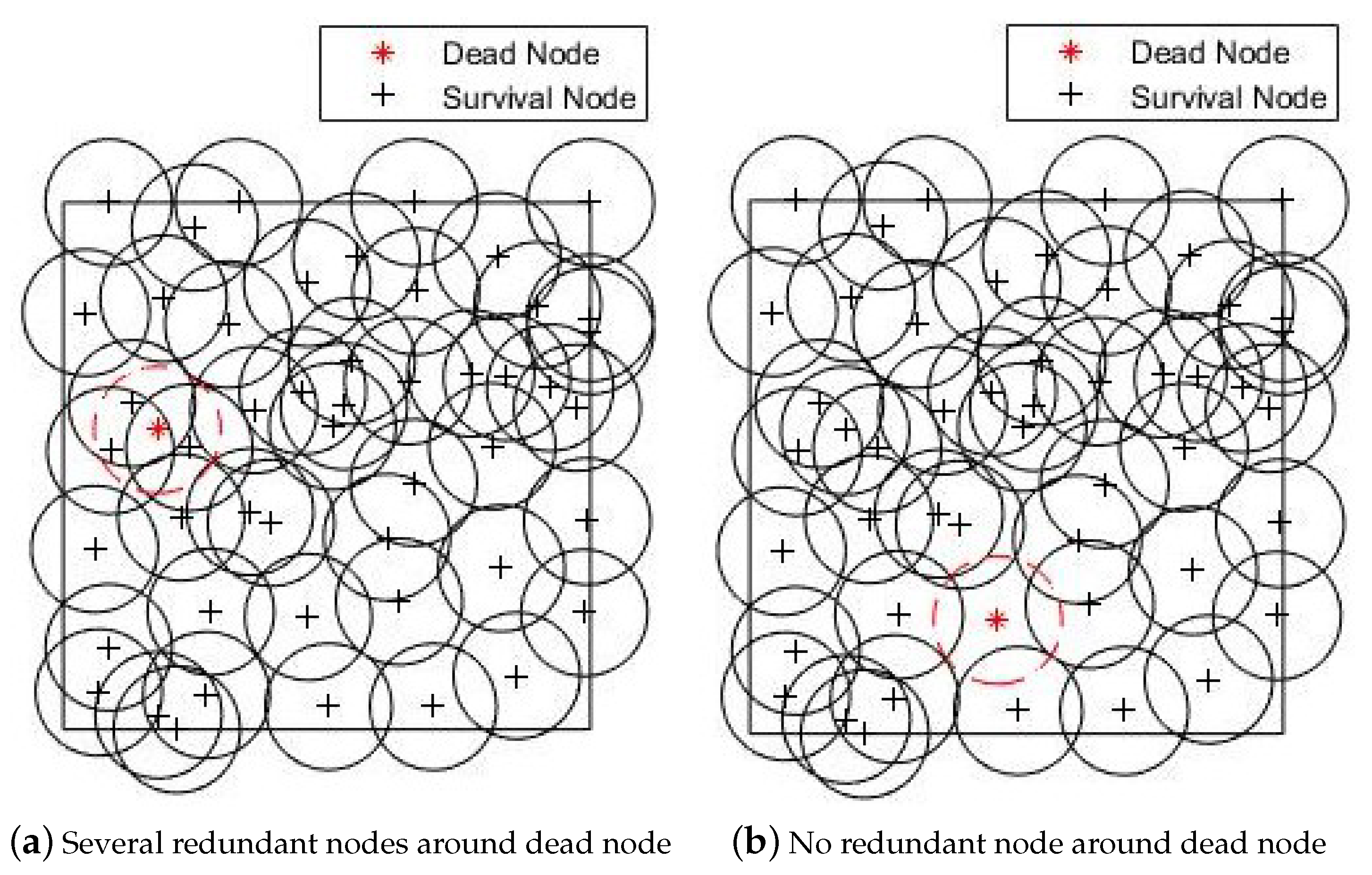
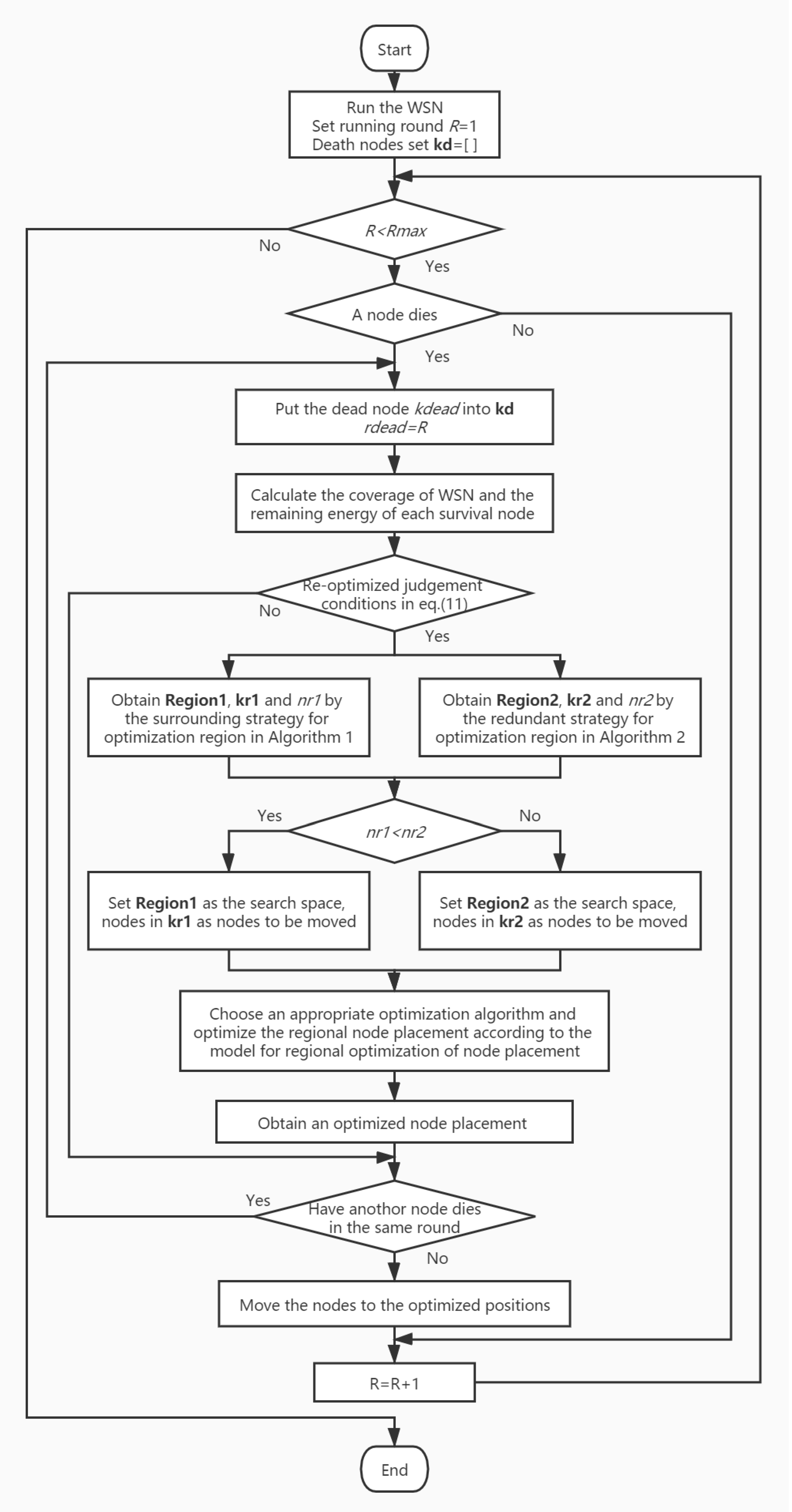
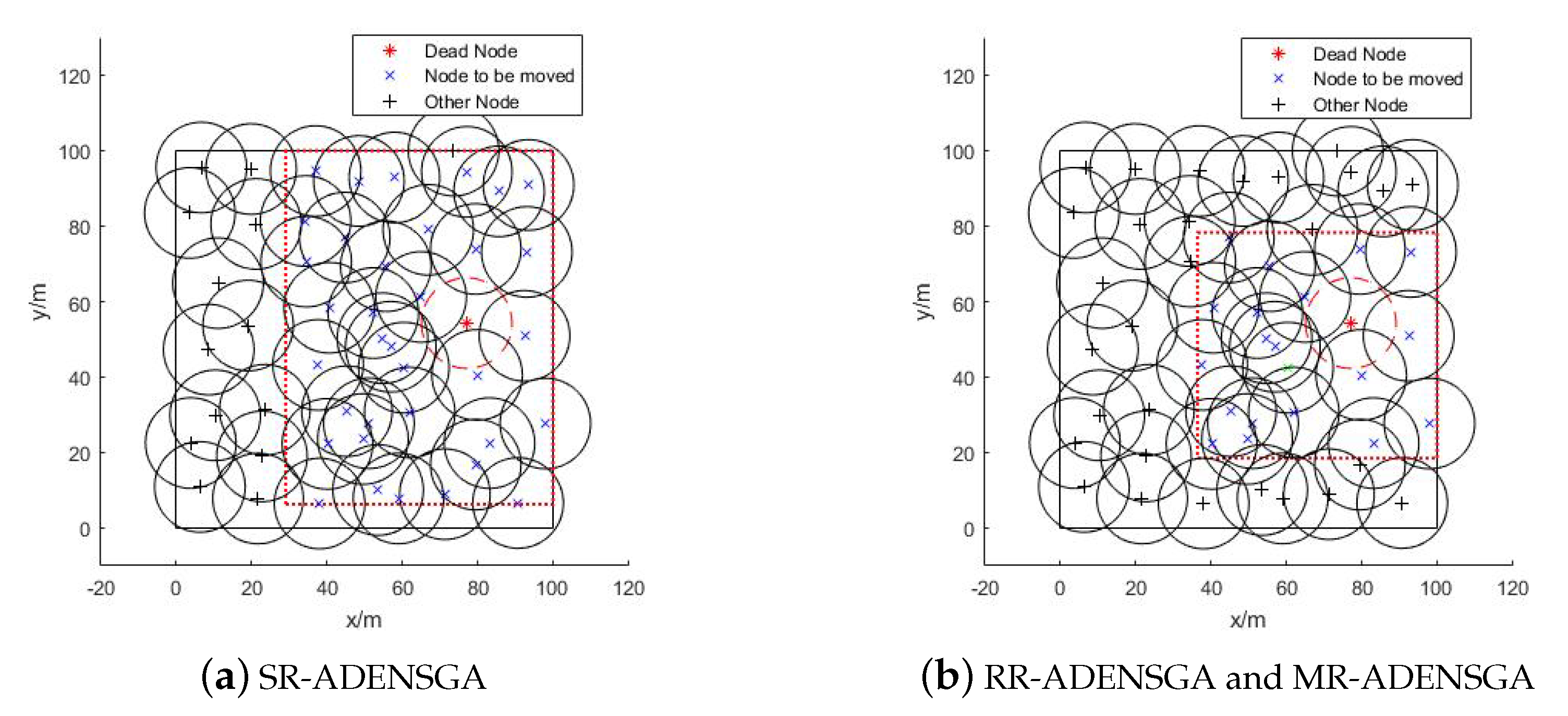
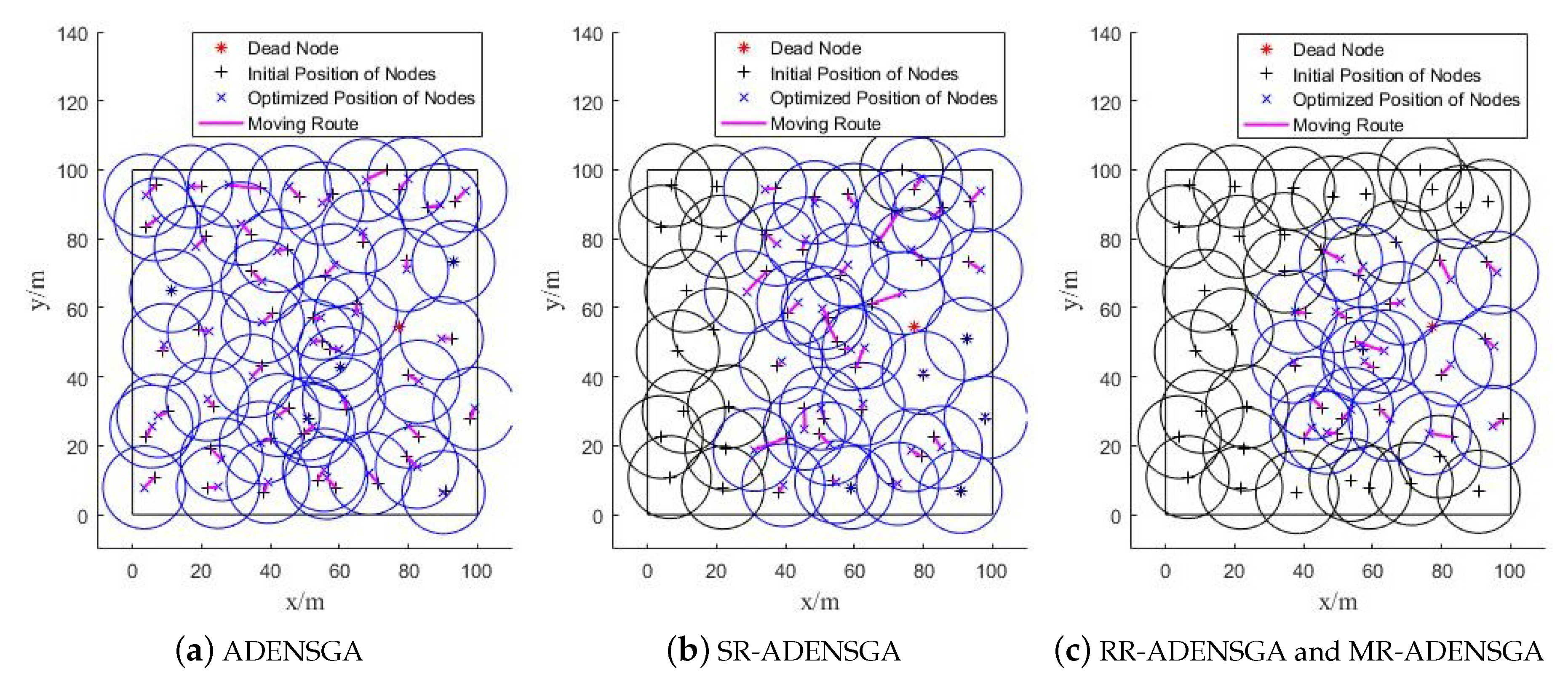


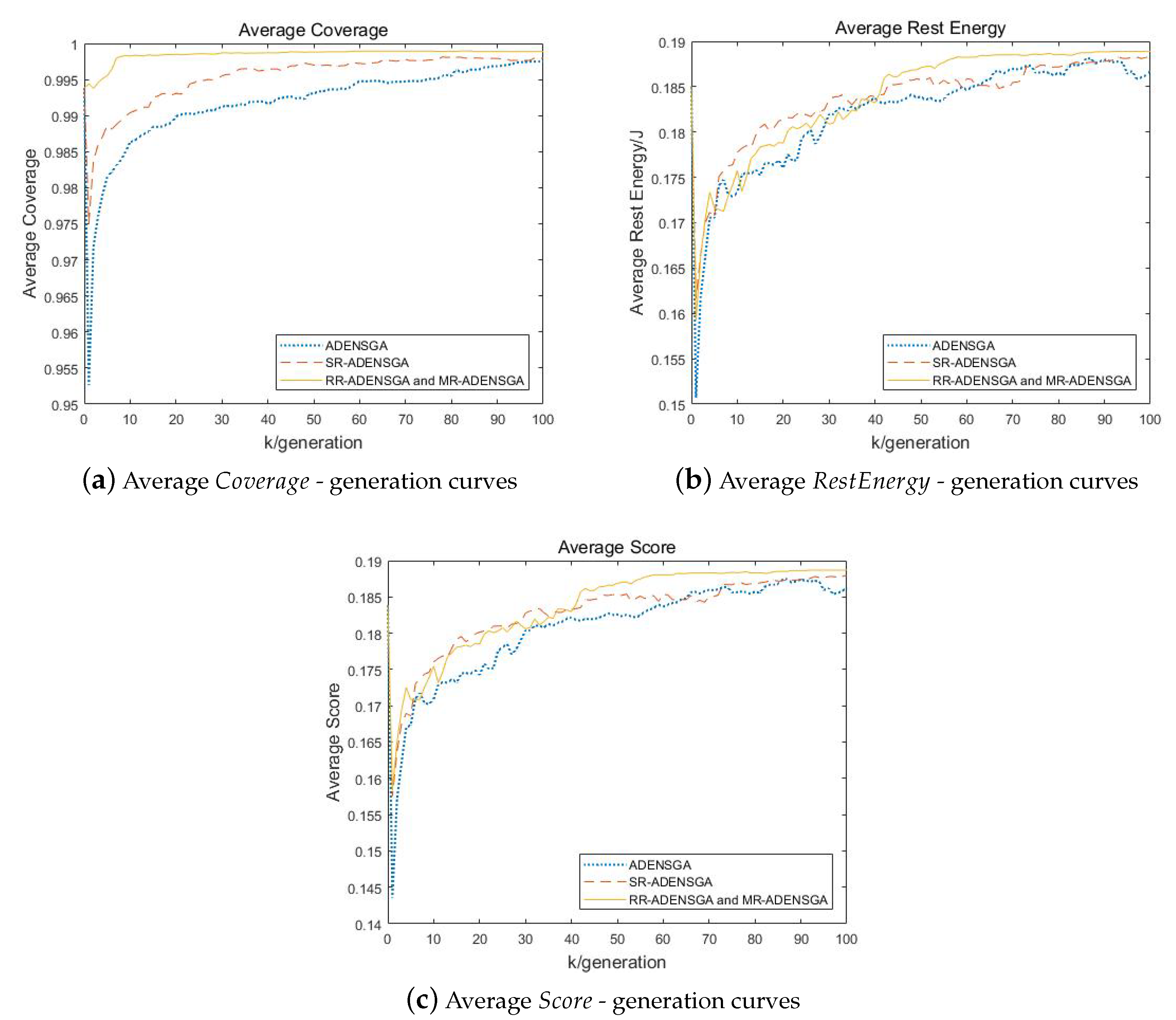
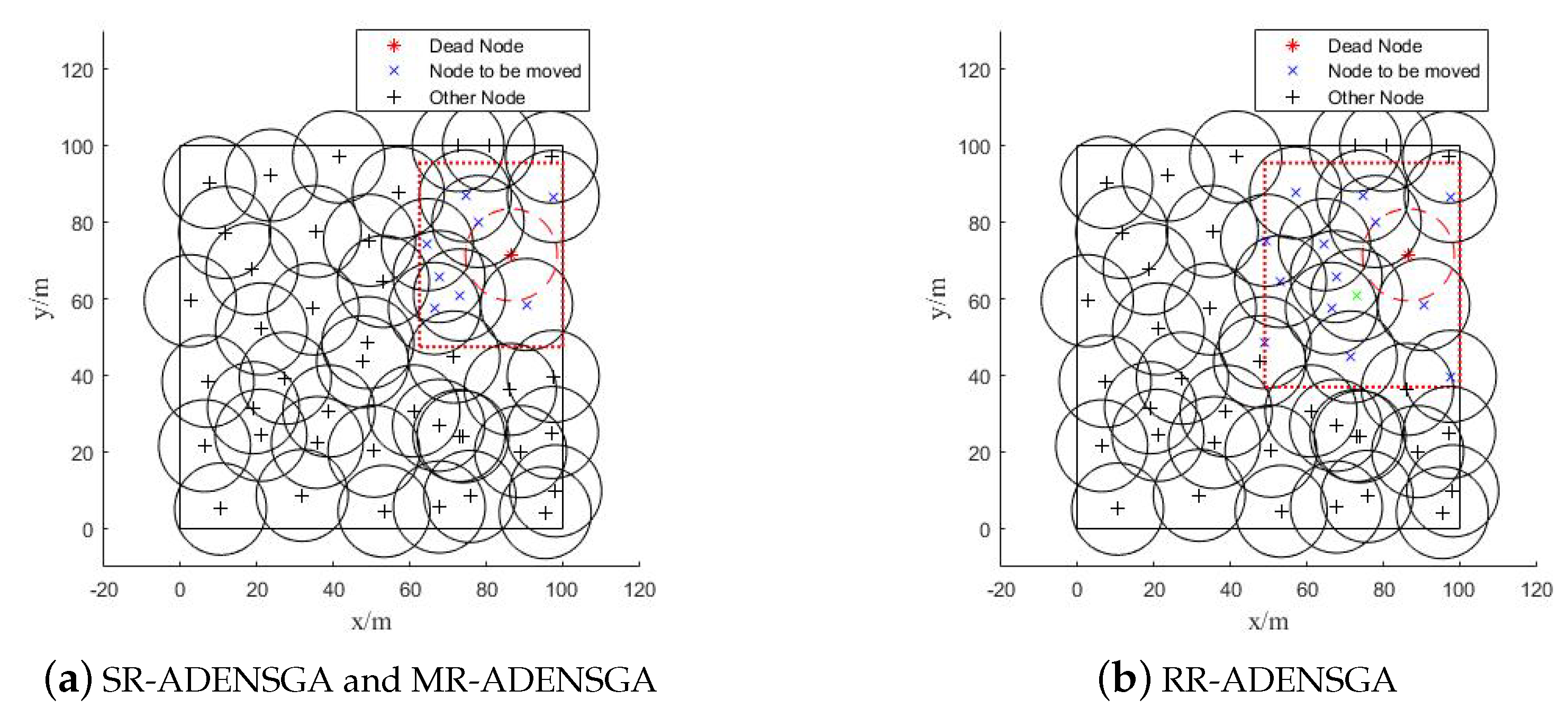
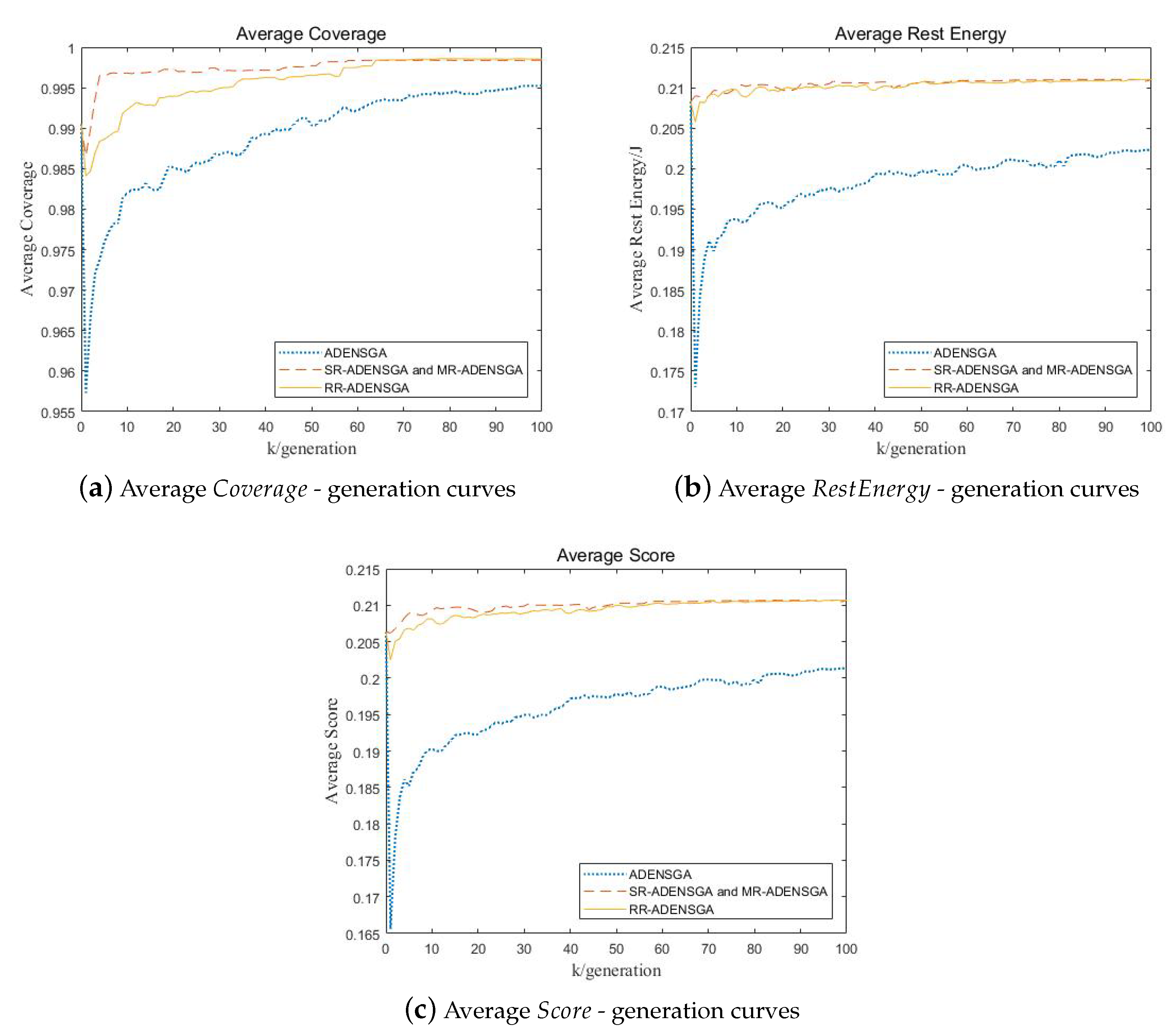
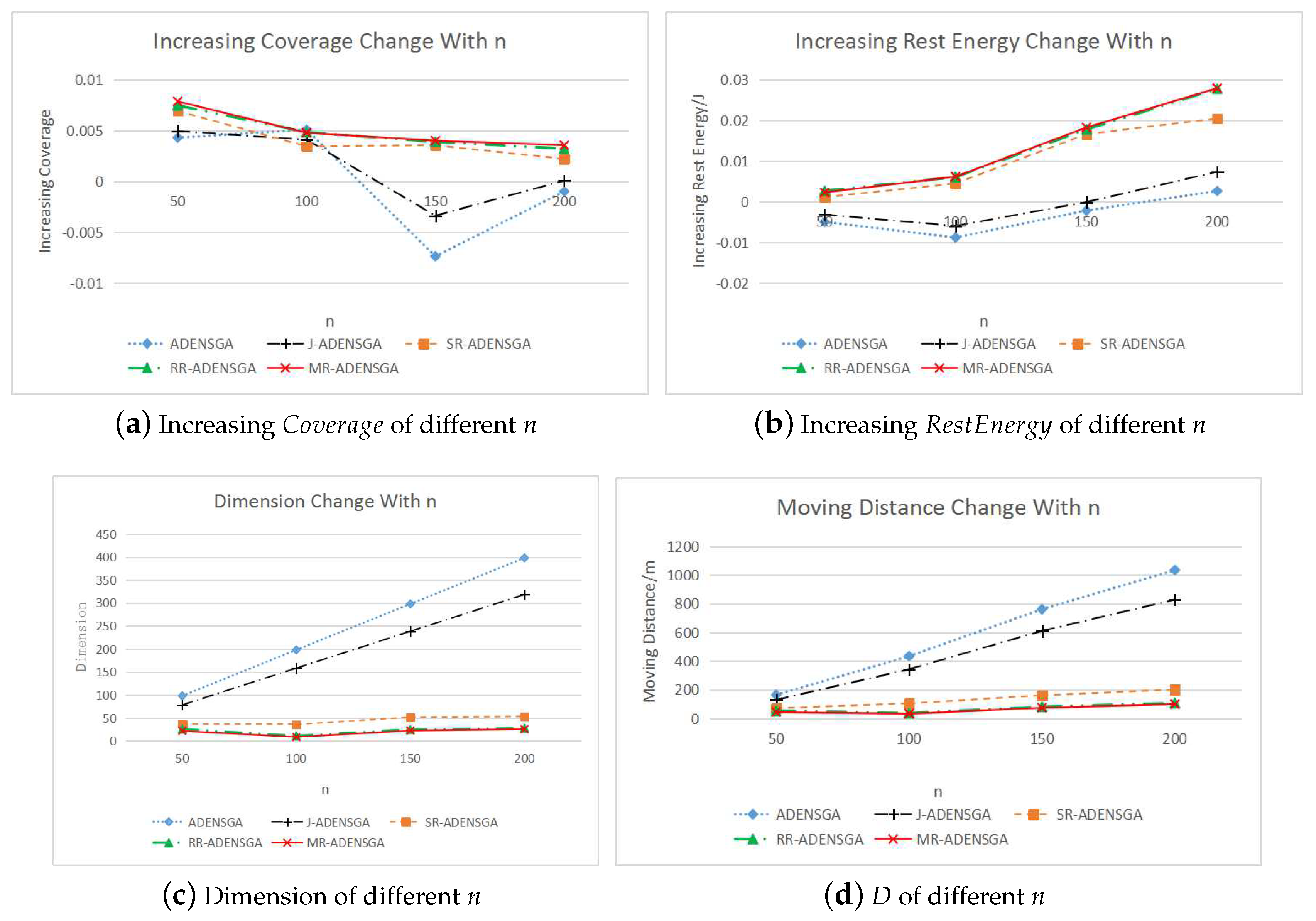
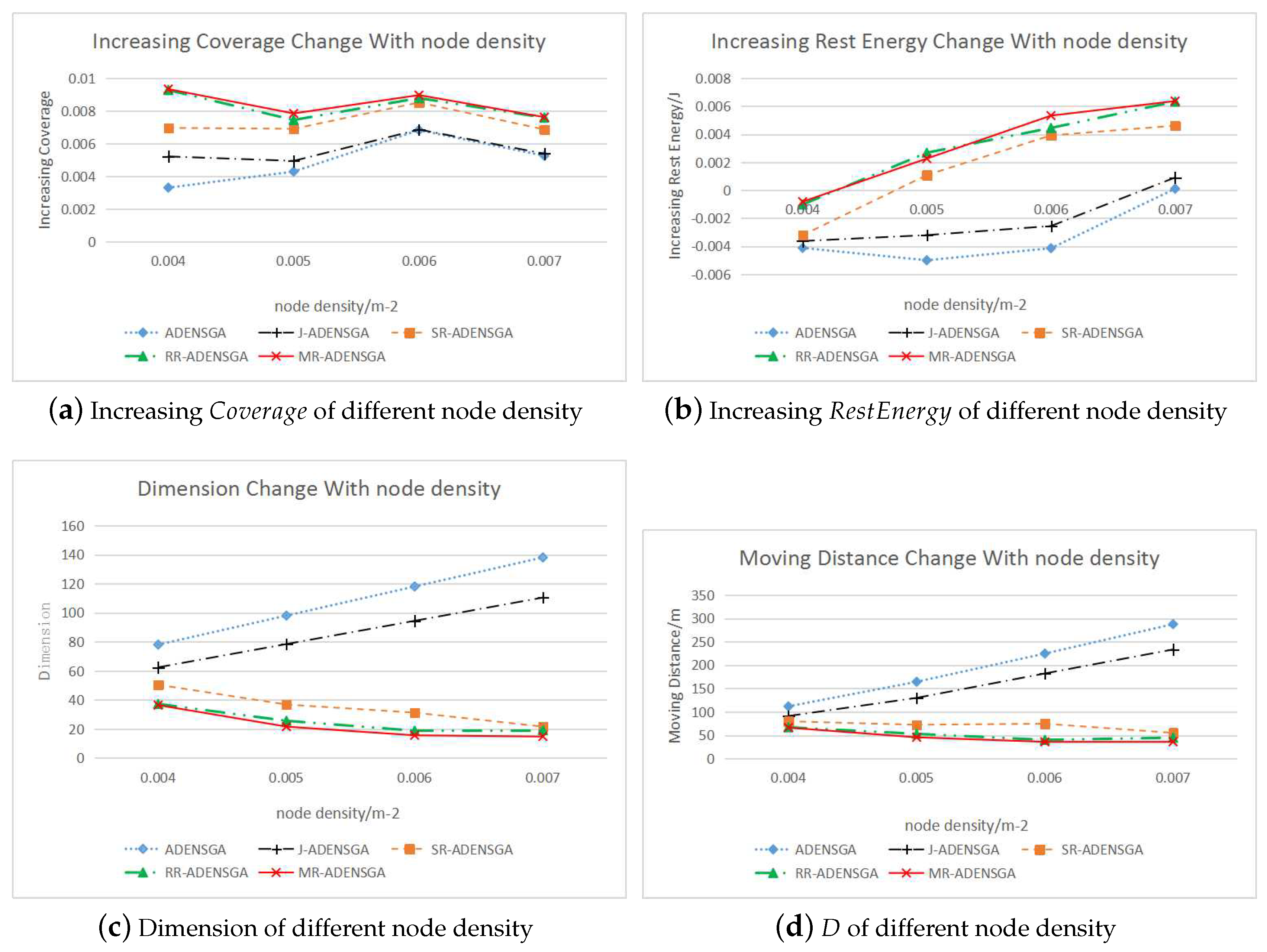
| Coordinates of the sink node, | |
| Node movement range coefficient, | 0.15 |
| Sensing range of the node, | 12 |
| Initial energy of nodes, | 0.5 |
| Energy consumption coefficient of node movement, | 5 × 10−3 |
| Excepted node number for an appropriate node density, | 50 |
| Size of the population, | 20 |
| Maximum generation of the algorithm, | 100 |
| Situations | Algorithms | Dimension of Solutions | Average | Average | Average | Average | Average | Average Running Time |
|---|---|---|---|---|---|---|---|---|
| Situation 1 Node Placement 1 | No optimization | - | 0.9907 | 0.2718 | 0.2693 | - | - | - |
| ADENSGA | 98 | 0.9935 ± 0.0020 | 0.2631 ± 0.0071 | 0.2614 ± 0.0066 | 164.5 ± 2.5 | 0.1702 | 123.3 | |
| SR-ADENSGA | 70 | 0.9963 ± 0.0037 | 0.2734 ± 0.0014 | 0.2724 ± 0.0012 | 127.2 ± 5.0 | 0.4403 | 124.5 | |
| RR-ADENSGA | 40 | 0.9991 ± 0.0002 | 0.2786 ± 0.0008 | 0.2783 ± 0.0007 | 82.0 ± 3.8 | 1.0244 | 121.9 | |
| MR-ADENSGA | 40 | 0.9991 ± 0.0002 | 0.2786 ± 0.0008 | 0.2783 ± 0.0007 | 82.0 ± 3.8 | 1.0244 | 121.9 | |
| Situation 2 Node Placement 1 | No optimization | - | 0.9938 | 0.1850 | 0.1839 | - | - | - |
| ADENSGA | 96 | 0.9975 ± 0.0006 | 0.1868 ± 0.0042 | 0.1863 ± 0.0041 | 146.8 ± 3.2 | 0.2520 | 193.7 | |
| SR-ADENSGA | 52 | 0.9980 ± 0.0003 | 0.1884 ± 0.0008 | 0.1880 ± 0.0007 | 96.3 ± 3.1 | 0.4361 | 194.5 | |
| RR-ADENSGA | 28 | 0.9989 ± 0.0002 | 0.1889 ± 0.0004 | 0.1887 ± 0.0004 | 48.9 ± 1.7 | 1.0440 | 192.0 | |
| MR-ADENSGA | 28 | 0.9989 ± 0.0002 | 0.1889 ± 0.0004 | 0.1887 ± 0.0004 | 48.9 ± 1.7 | 1.0440 | 192.0 | |
| Situation 3 Node Placement 2 | No optimization | - | 0.9806 | 0.2973 | 0.2915 | - | - | - |
| ADENSGA | 98 | 0.9880 ± 0.0094 | 0.3026 ± 0.0109 | 0.2989 ± 0.0098 | 165.4 ± 12.7 | 0.4474 | 157.3 | |
| SR-ADENSGA | 22 | 0.9924 ± 0.0000 | 0.3123 ± 0.0001 | 0.3099 ± 0.0001 | 45.9 ± 0.6 | 2.5708 | 154.4 | |
| RR-ADENSGA | 40 | 0.9917 ± 0.0005 | 0.3122 ± 0.0005 | 0.3096 ± 0.0003 | 83.0 ± 5.4 | 1.3373 | 156.3 | |
| MR-ADENSGA | 22 | 0.9924 ± 0.0000 | 0.3123 ± 0.0001 | 0.3099 ± 0.0001 | 45.9 ± 0.6 | 2.5708 | 154.4 | |
| Situation 4 Node Placement 2 | No optimization | - | 0.9918 | 0.3441 | 0.3413 | - | - | - |
| ADENSGA | 98 | 0.9935 ± 0.0035 | 0.3366 ± 0.0070 | 0.3344 ± 0.0059 | 176.9 ± 9.9 | 0.0961 | 178.3 | |
| SR-ADENSGA | 0 | 0.9918 | 0.3441 | 0.3413 | 0 | 0 | 0.0059 | |
| RR-ADENSGA | 0 | 0.9918 | 0.3441 | 0.3413 | 0 | 0 | 0.0090 | |
| MR-ADENSGA | 0 | 0.9918 | 0.3441 | 0.3413 | 0 | 0 | 0.0150 | |
| Situation 5 Node Placement 3 | No optimization | - | 0.9772 | 0.2186 | 0.2136 | - | - | - |
| ADENSGA | 98 | 0.9910 ± 0.0005 | 0.2031 ± 0.0092 | 0.2017 ± 0.0091 | 173.0 ± 6.1 | 0.7977 | 129.9 | |
| SR-ADENSGA | 94 | 0.9881 ± 0.0027 | 0.2149 ± 0.0036 | 0.2125 ± 0.0031 | 181.5 ± 9.4 | 0.6006 | 133.5 | |
| RR-ADENSGA | 24 | 0.9915 ± 0.0018 | 0.2220 ± 0.0007 | 0.2198 ± 0.0005 | 47.9 ± 1.9 | 2.9854 | 132.4 | |
| MR-ADENSGA | 24 | 0.9915 ± 0.0018 | 0.2220 ± 0.0007 | 0.2198 ± 0.0005 | 47.9 ± 1.9 | 2.9854 | 132.4 | |
| Situation 6 Node Placement 3 | No optimization | - | 0.9835 | 0.0415 | 0.0408 | - | - | - |
| ADENSGA | 96 | 0.9924 ± 0.0034 | 0.0316 ± 0.0052 | 0.0313 ± 0.0041 | 157.2 ± 8.7 | 0.5661 | 197.3 | |
| SR-ADENSGA | 0 | 0.9835 | 0.0415 | 0.0408 | 0 | 0 | 0.0129 | |
| RR-ADENSGA | 0 | 0.9835 | 0.0415 | 0.0408 | 0 | 0 | 0.0079 | |
| MR-ADENSGA | 0 | 0.9835 | 0.0415 | 0.0408 | 0 | 0 | 0.0209 | |
| Situation 7 Node Placement 4 | No optimization | - | 0.9907 | 0.2754 | 0.2728 | - | - | - |
| ADENSGA | 98 | 0.9932 ± 0.0056 | 0.2693 ± 0.0080 | 0.2675 ± 0.0067 | 175.6 ± 7.1 | 0.1425 | 144.7 | |
| SR-ADENSGA | 16 | 0.9993 ± 0.0001 | 0.2802 ± 0.0002 | 0.2800 ± 0.0002 | 34.0 ± 2.0 | 2.5294 | 142.2 | |
| RR-ADENSGA | 20 | 0.9992 ± 0.0003 | 0.2802 ± 0.0002 | 0.2800 ± 0.0002 | 47.6 ± 4.4 | 1.7857 | 142.2 | |
| MR-ADENSGA | 16 | 0.9993 ± 0.0001 | 0.2802 ± 0.0002 | 0.2800 ± 0.0002 | 34.0 ± 2.0 | 2.5294 | 142.2 | |
| Situation 8 Node Placement 4 | No optimization | - | 0.9859 | 0.2238 | 0.2206 | - | - | - |
| ADENSGA | 96 | 0.9910 ± 0.0045 | 0.2291 ± 0.0046 | 0.2270 ± 0.0037 | 162.8 ± 6.7 | 0.3132 | 200.7 | |
| SR-ADENSGA | 78 | 0.9898 ± 0.0053 | 0.2249 ± 0.0089 | 0.2226 ± 0.0079 | 147.3 ± 6.6 | 0.2648 | 199.9 | |
| RR-ADENSGA | 20 | 0.9978 ± 0.0006 | 0.2342 ± 0.0002 | 0.2337 ± 0.0000 | 38.0 ± 2.6 | 3.1316 | 198.3 | |
| MR-ADENSGA | 20 | 0.9978 ± 0.0006 | 0.2342 ± 0.0002 | 0.2337 ± 0.0000 | 38.0 ± 2.6 | 3.1316 | 198.3 | |
| Situation 9 Node Placement 5 | No optimization | - | 0.9905 | 0.2083 | 0.2063 | - | - | - |
| ADENSGA | 98 | 0.9955 ± 0.0053 | 0.1992 ± 0.0068 | 0.1983 ± 0.0063 | 172.1 ± 10.5 | 0.2901 | 129.8 | |
| SR-ADENSGA | 16 | 0.9985 ± 0.0005 | 0.2113 ± 0.0003 | 0.2109 ± 0.0004 | 24.9 ± 0.2 | 3.2129 | 133.3 | |
| RR-ADENSGA | 28 | 0.9981 ± 0.0042 | 0.2109 ± 0.0003 | 0.2105 ± 0.0008 | 57.6 ± 1.7 | 1.3194 | 132.0 | |
| MR-ADENSGA | 16 | 0.9985 ± 0.0005 | 0.2113 ± 0.0003 | 0.2109 ± 0.0004 | 24.9 ± 0.2 | 3.2129 | 133.3 | |
| Situation 10 Node Placement 5 | No optimization | - | 0.9971 | 0.3353 | 0.3343 | - | - | - |
| ADENSGA | 98 | 0.9989 ± 0.0007 | 0.3338 ± 0.0022 | 0.3334 ± 0.0021 | 162.9 ± 3.9 | 0.1105 | 167.1 | |
| SR-ADENSGA | 0 | 0.9971 | 0.3353 | 0.3343 | 0 | 0 | 0.0044 | |
| RR-ADENSGA | 0 | 0.9971 | 0.3353 | 0.3343 | 0 | 0 | 0.0070 | |
| MR-ADENSGA | 0 | 0.9971 | 0.3353 | 0.3343 | 0 | 0 | 0.0115 |
| ADENSGA | SR-ADENSGA | RR-ADENSGA | MR-ADENSGA | |
|---|---|---|---|---|
| Average Round of Next Node Dead | 671.2 | 681.3 | 683.9 | 684.3 |
| Average Round of Half Node Dead | 852.0 | 861.3 | 864.4 | 868.5 |
| Average Round of All Node Dead | 1334.6 | 1383.5 | 1367.1 | 1383.6 |
© 2020 by the authors. Licensee MDPI, Basel, Switzerland. This article is an open access article distributed under the terms and conditions of the Creative Commons Attribution (CC BY) license (http://creativecommons.org/licenses/by/4.0/).
Share and Cite
Zhang, Y.; Liu, M. Regional Optimization Dynamic Algorithm for Node Placement in Wireless Sensor Networks. Sensors 2020, 20, 4216. https://doi.org/10.3390/s20154216
Zhang Y, Liu M. Regional Optimization Dynamic Algorithm for Node Placement in Wireless Sensor Networks. Sensors. 2020; 20(15):4216. https://doi.org/10.3390/s20154216
Chicago/Turabian StyleZhang, Yijie, and Mandan Liu. 2020. "Regional Optimization Dynamic Algorithm for Node Placement in Wireless Sensor Networks" Sensors 20, no. 15: 4216. https://doi.org/10.3390/s20154216
APA StyleZhang, Y., & Liu, M. (2020). Regional Optimization Dynamic Algorithm for Node Placement in Wireless Sensor Networks. Sensors, 20(15), 4216. https://doi.org/10.3390/s20154216





